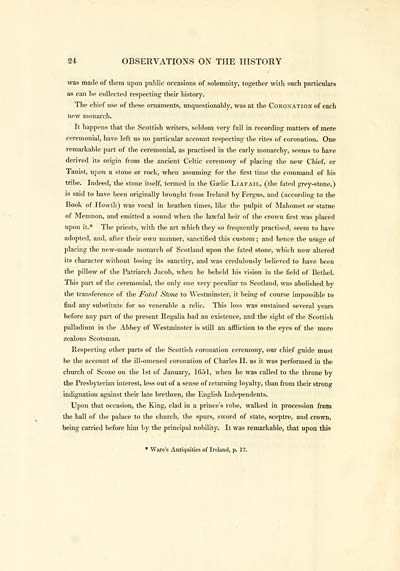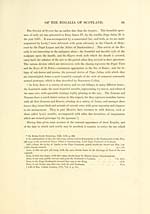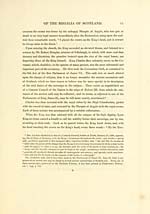Bannatyne Club > Papers relative to the Regalia of Scotland
(54) Page 24
Download files
Complete book:
Individual page:
Thumbnail gallery: Grid view | List view

24 OBSERVATIONS ON THE HISTORY
was made of them upon public occasions of solemnity, together with such particulars
as can be collected respecting their history.
The chief use of these ornaments, unquestionably, was at the Coronation of each
new monarcli.
It happens that the Scottish writers, seldom very full in recording matters of mere
ceremonial, have left us no particular account respecting the rites of coronation. One
remarkable part of the ceremonial, as practised in the early monarchy, seems to hare
derived its origin from the ancient Celtic ceremony of placing the new Chief, or
Tanist, upon a stone or rock, when assuming for the first time the command of his
tribe. Indeed, the stone itself, termed in the Gaelic Liafail, (the fated grey-stone,)
is said to have been originally brought from Ireland by Fergus, and (according to the
Book of Howth) was vocal in heathen times, like the pulpit of Mahomet or statue
of Memnon, and emitted a sound when the lawful heir of the crown first was placed
upon it.* The priests, with the art which they so frequently practised, seem to have
adopted, and, after their own manner, sanctified this custom ; and hence the usage of
placbg the new-made monai-ch of Scotland upon the fated stone, which now altered
its character without losing its sanctity, and was credulously believed to have been
the pillow of the Patriarch Jacob, when he beheld his vision in the field of Bethel.
This part of the ceremonial, the only one very peculiar to Scotland, was abolished by
the transference of the Fatal Stone to Westminster, it being of course impossible to
find any substitute for so venemble a relic. This loss was sustained several years
before any part of the present Regalia had an existence, and the sight of the Scottish
palladium in the Abbey of Westminster is still an affliction to the eyes of the more
zealous Scotsman.
Respecting other parts of the Scottish coronation ceremony, ovu- chief guide must
be the account of the ill-omened coronation of Charles II. as it was performed in the
church of Scone on the 1st of January, 1651, when he was called to the throne by
the Presbyterian interest, less out of a sense of returning loyalty, than from then- strong
indignation against their late brethren, the English Independents.
Upon that occasion, the King, clad in a prince's robe, walked in procession from
the hall of the palace to the church, the spurs, sword of state, sceptre, and crown,
being carried before him by the principal nobility. It was remarkable, that upon this
• Ware's Antiquities of Ireland, p. 17.
was made of them upon public occasions of solemnity, together with such particulars
as can be collected respecting their history.
The chief use of these ornaments, unquestionably, was at the Coronation of each
new monarcli.
It happens that the Scottish writers, seldom very full in recording matters of mere
ceremonial, have left us no particular account respecting the rites of coronation. One
remarkable part of the ceremonial, as practised in the early monarchy, seems to hare
derived its origin from the ancient Celtic ceremony of placing the new Chief, or
Tanist, upon a stone or rock, when assuming for the first time the command of his
tribe. Indeed, the stone itself, termed in the Gaelic Liafail, (the fated grey-stone,)
is said to have been originally brought from Ireland by Fergus, and (according to the
Book of Howth) was vocal in heathen times, like the pulpit of Mahomet or statue
of Memnon, and emitted a sound when the lawful heir of the crown first was placed
upon it.* The priests, with the art which they so frequently practised, seem to have
adopted, and, after their own manner, sanctified this custom ; and hence the usage of
placbg the new-made monai-ch of Scotland upon the fated stone, which now altered
its character without losing its sanctity, and was credulously believed to have been
the pillow of the Patriarch Jacob, when he beheld his vision in the field of Bethel.
This part of the ceremonial, the only one very peculiar to Scotland, was abolished by
the transference of the Fatal Stone to Westminster, it being of course impossible to
find any substitute for so venemble a relic. This loss was sustained several years
before any part of the present Regalia had an existence, and the sight of the Scottish
palladium in the Abbey of Westminster is still an affliction to the eyes of the more
zealous Scotsman.
Respecting other parts of the Scottish coronation ceremony, ovu- chief guide must
be the account of the ill-omened coronation of Charles II. as it was performed in the
church of Scone on the 1st of January, 1651, when he was called to the throne by
the Presbyterian interest, less out of a sense of returning loyalty, than from then- strong
indignation against their late brethren, the English Independents.
Upon that occasion, the King, clad in a prince's robe, walked in procession from
the hall of the palace to the church, the spurs, sword of state, sceptre, and crown,
being carried before him by the principal nobility. It was remarkable, that upon this
• Ware's Antiquities of Ireland, p. 17.
Set display mode to: Large image | Transcription
Images and transcriptions on this page, including medium image downloads, may be used under the Creative Commons Attribution 4.0 International Licence unless otherwise stated. ![]()
| Publications by Scottish clubs > Bannatyne Club > Papers relative to the Regalia of Scotland > (54) Page 24 |
|---|
| Permanent URL | https://digital.nls.uk/81104724 |
|---|
| Description | Place of publication Edinburgh unless otherwise stated. No. 125 is relative to but not part of the club's series. |
|---|---|

